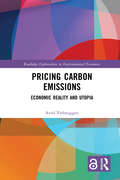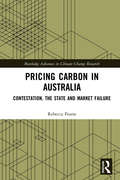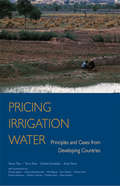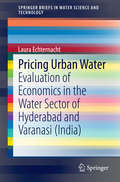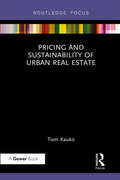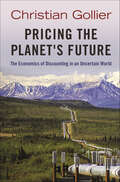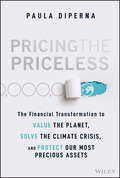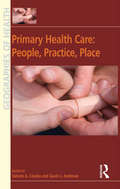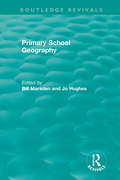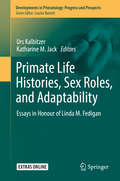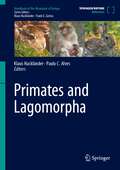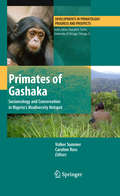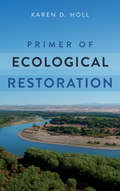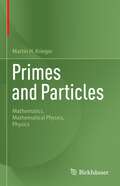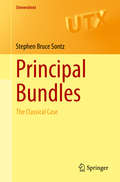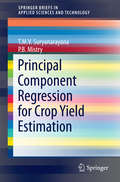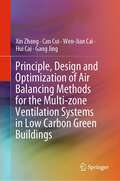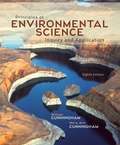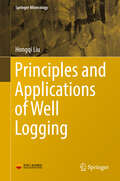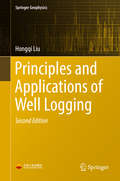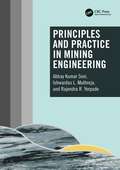- Table View
- List View
Pricing Carbon Emissions: Economic Reality and Utopia (Routledge Explorations in Environmental Economics)
by Aviel VerbruggenPricing Carbon Emissions provides an economic critique on the utopian idea of a uniform carbon price for addressing rising carbon emissions, exposing the flaws in the economic propositions with a key focus on the EU’s Emissions Trading System (ETS). After an Executive Summary of the contents, the chapters build up understanding of orthodox economics’ role in protecting the neoliberal paradigm. A salient case, the ETS is successful in shielding the Business-as-Usual activities of the EU’s industry, however this book argues that the system fails in creating innovation for decarbonizing production technologies. A subsequent political economy analysis by the author points to the discursive power of giant fossil fuel and electricity companies keeping up a façade of Cap-and-Trade utopia and hiding the reality of free permit donations and administrative price control, concealing financial bills mostly paid by household electricity customers. The twilights between reality and utopia in the EU’s ETS are exposed, concluding an immediate end of the system is necessary for effective and just climate policy. The work argues that the proposition of shifting to a global uniform carbon tax is equally utopian. In practice, a uniform price applied on heterogeneous cases is not a source of benefits but one of ad-hoc adjustments, exceptions, and exemptions. Carbon pricing does not induce innovation, however assumed by the economic models used by IPCC for advising global climate policy. Thus, it is persuasively demonstrated by the author that these schemes are doomed to failure and room and resources need to be created for more effective and just climate politics. The book’s conclusion is based on economic arguments, complementing the critique of political scientists. This book is written for a broad audience interested in climate policy eager to understand why decarbonizing progress is slow as it is. It marks a significant addition to the literature on climate politics, carbon pricing and the political economy of the environment more broadly. The Open Access version of this book, available at www.taylorfrancis.com, has been made available under a Creative Commons Attribution-Non Commercial-No Derivatives 4.0 license.
Pricing Carbon in Australia: Contestation, the State and Market Failure (Routledge Advances in Climate Change Research)
by Rebecca PearseIn the mid-2000s it seemed that the global carbon market would take off and spark the worldwide transition to a profitable low carbon economy. A decade on, the experiment in carbon trading is failing. Carbon market schemes have been plagued by problems and resistance to carbon pricing has come from the political Left and Right. In the Australian case, a national emissions trading scheme (ETS) was dismantled after a long, bitter public debate. The replacement ‘Direct Action Plan’ is also in disrepute. Pricing Carbon in Australia examines the rise and fall of the ETS in Australia between 2007 and 2015, exploring the underlying contradictions of marketised climate policy in detail. Through this and other international examples, the book offers a critique of the political economy of marketised climate policy, exploring why the hopes for global carbon trading have been dashed. The Australian case is interpreted in light of a broader legitimation crisis as state strategies for (temporarily) displacing the climate crisis continue to fail. Importantly, in the wake of carbon market failure, alternative agendas for state action are emerging as campaigns for the retrenchment of fossil fuel assets and for just renewable energy transition continue transforming climate politics and policy as we know it. This book is a valuable resource for practitioners and academics in the fields of environmental policy and politics and social movement studies.
Pricing Irrigation Water: Principles and Cases from Developing Countries
by Yacov TsurAs globalization links economies, the value of a country's irrigation water becomes increasingly sensitive to competitive forces in world markets. Water policy at the national and regional levels will need to accommodate these forces or water is likely to become undervalued. The inefficient use of this resource will lessen a country's comparative advantage in world markets and slow its transition to higher incomes, particularly in rural households. While professionals widely agree on what constitutes sound water resource management, they have not yet reached a consensus on the best ways of implementing policies. Policymakers have considered pricing water - a debated intervention - in many variations. Setting the price 'right,' some say, may guide different types of users in efficient water use by sending a signal about the value of this resource. Aside from efficiency, itself an important policy objective, equity, accessibility, and implementation costs associated with the right pricing must be considered. Focusing on the examples of China, Mexico, Morocco, South Africa, and Turkey, Pricing Irrigation Water provides a clear methodology for studying farm-level demand for irrigation water. This book is the first to link the macroeconomics of policies affecting trade to the microeconomics of water demand for irrigation and, in the case of Morocco, to link these forces to the creation of a water user-rights market. This type of market reform, the contributors argue, will result in growing economic benefits to both rural and urban households.
Pricing Urban Water
by Laura EchternachtHigh population growth, informal settlements, and organizational and financial mismanagement represent major challenges for the water supply in many cities in developing countries. This book contributes to solving those problems by identifying systematic shortcomings and proposing solutions to improve the financial conditions in two representative cities: Hyderabad and Varanasi. Serious improvements are necessary for the further development of the water supply and sanitation networks in these areas. Pricing Urban Water offers a theoretical introduction to economics of the water sector, including the theory of water pricing and tariff systems, combined with detailed analyses of the water supply and sanitation infrastructure as well as of the municipal suppliers of Hyderabad and Varanasi. Introducing a method for estimating future water production costs in both cities serves as the basis for a tariff revision, which is put forward as one solution to improve the poor financial conditions both suppliers are in. Besides the revision of the tariff systems, some considerations on how to supply and charge urban poor and on the inclusion of private borewells in the tariffs are part of the discussion. Changes in both the organizational structure of the service providers and in the current delivery and use of the services are presented as further solutions to the problems in this sector.
Pricing and Sustainability of Urban Real Estate
by Tom KaukoUrban sustainability has become a political and social agenda of global significance, of which real estate is an integral dimension. Sustainable urban development includes much more than ‘green building’ standards, yet in practice, other aspects such land use plans and locations are often overlooked. This book demonstrates that the issue of sustainable development stretches far beyond the hitherto dominating agenda based on ‘green’ (i.e. environmentally and ecologically sustainable) buildings. In doing so, it presents a novel framework based on the concept of economic sustainability of real estate locations, drawing connections with the global financial crisis and housing price bubble discourse. It argues for the need to better integrate social, cultural and economic dimensions into the real estate sustainability agenda. It also explores the role of location, and especially the image aspect therein. Trends in consumer choice are important to the way these dimensions are appreciated in decisions about investment, development, valuation and other activities of the production, consumption and governance of the built environment. This book will be of interest to private and public sector practitioners of real estate valuation as well as scholars of urban studies, geography, economics, urban planning and environmental studies.
Pricing the Planet's Future: The Economics of Discounting in an Uncertain World
by Christian GollierOur path of economic development has generated a growing list of environmental problems including the disposal of nuclear waste, exhaustion of natural resources, loss of biodiversity, climate change, and polluted land, air, and water. All these environmental problems raise the crucial challenge of determining what we should and should not do for future generations. It is also central to other policy debates, including, for example, the appropriate level of public debt, investment in public infrastructure, investment in education, and the level of funding for pension benefits and for research and development. Today, the judge, the citizen, the politician, and the entrepreneur are concerned with the sustainability of our development. The objective of Pricing the Planet's Future is to provide a simple framework to organize the debate on what we should do for the future. A key element of analysis by economists is the discount rate--the minimum rate of return required from an investment project to make it desirable to implement. Christian Gollier outlines the basic theory of the discount rate and the various arguments that favor using a smaller discount rate for more distant cash flows. With principles that can be applied to many policy areas, Pricing the Planet's Future offers an ideal framework for dynamic problems and decision making.
Pricing the Priceless: The Financial Transformation to Value the Planet, Solve the Climate Crisis, and Protect Our Most Precious Assets
by Paula DiPernaAn exciting exploration of the new frontier of finance, to value the planet and protect what has too long been treated as free and taken for granted--the natural assets we need and love most In Pricing the Priceless: The Financial Transformation to Value the Planet, Solve the Climate Crisis, and Protect Our Most Precious Assets, renowned environmental strategist, speaker, world traveler and author Paula DiPerna brings a unique voice and optic to de-mystify and unveil today’s most fascinating financial disruption—pricing the priceless to flip conventional ideas of how we value natural assets and why. She asks the provocative question long ignored: Why do we value the indispensable atmosphere at zero, but dispensable production in the trillions? She digs into alternatives, with real-life examples from around the globe of fascinating and pioneering financial innovations—controversial and paradoxical, but essential. In the book, you’ll travel from rainforests to Wall Street, Board Rooms to the Vatican, coral reefs to mangroves to China’s carbon markets. Timely, adventurous, eclectic, and accessible, Pricing the Priceless brings alive the critical financial transformation that will determine future planetary health and social stability. With power, clarity and real-world experience, the author also examines: Fascinating new financial inventions and experiments—insurance, bonds, markets, investment funds—all aimed at pricing what is precious and vital to human well-being How the great current intergenerational shift in wealth and attitudes is redefining investment trends and the idea of what constitutes wealth and return How climate change and other urgent environmental problems now require entirely new financial thinking to trigger solutions How once-radical ideas about measuring economic progress are now re-imagining the very purpose of capitalism Why finance needs critical re-invention to remain credible in the face of increasing public skepticism of business-as-usual economic practice A can’t-miss read for thought leaders, business executives, investors, activists, and entrepreneurs, Pricing the Priceless is a landmark that will shape the world and future, bridging the tangible and intangible to answer a critical question of rising economic and social inspiration: What is money for?
Primary Health Care: People Practice Place (Geographies of Health Series)
by Gavin J. AndrewsHealth care is constantly undergoing change and refinement resulting from the adoption of new practices and technologies, the changing nature of societies and populations, and also shifts in the very places from which care is delivered. Primary Health Care: People, Practice, Place draws together significant contributions from established experts across a variety of disciplines to focus on such changes in primary health care, not only because it is the most basic and integral form of health service delivery, but also because it is an area to which geographers have made significant contributions and to which other scholars have engaged in 'thinking geographically' about its core concepts and issues. Including perspectives from both consumers and producers, it moves beyond geographical accounts of the context of health service provision through its explicit focus on the practice of primary health care. With arguments well-supported by empirical research, this book will appeal not only to scholars across a range of social and health sciences, but also to professionals involved in health services.
Primary School Geography (Routledge Revivals)
by Bill Marsden Jo HughesPublished in 1994, this book is the result of the collaborative work undertaken at the Liverpool-based Geography INSET Primary Project (GIPP) over three years. It presents a series of chapters for primary teachers seeking to implement the Statutory Orders for Geography in the National Curriculum. Steering a middle course between the sophistications of a theoretical/methodological text and the over-simplifications of a ‘tips-for-teachers’ approach, the authors highlight the positive opportunities offered by the National Curriculum. At the same time they are critical of many aspects of the Statutory Orders, without losing sight of their objective to help teachers to improve the quality of primary geography teaching. The book is especially useful for INSET work for teachers who have already grappled with National Curriculum Geography and who will be adjusting to the post-Dearing rearrangements.
Primate Life Histories, Sex Roles, and Adaptability: Essays in Honour of Linda M. Fedigan (Developments in Primatology: Progress and Prospects)
by Urs Kalbitzer Katharine M. JackProfessor Linda M. Fedigan, Member of the Order of Canada and a Fellow of the Royal Society of Canada, has made major contributions to our understanding of the behavioural ecology of primates. Furthermore, Linda Fedigan pioneered and continues to advance scholarship on the role of women in science, as well as actively promoting the inclusion of women in the academy. A symposium in honour of her career was held in Banff (Alberta, Canada) in December 2016, during which former and current students and collaborators, as well as scientists with similar research interests, presented and discussed their work and their connections to Linda Fedigan. These presentations and discussions are here presented as chapters in this festschrift. The original works presented in this book are organized around four major research areas that have been greatly advanced and influenced by Linda Fedigan:Primate life historiesSex roles, gender, and sciencePrimate-environment interactionsPrimate adaptation to changing environments
Primate Tourism
by Anne E. Russon Janette WallisPrimate tourism is a growing phenomenon, with increasing pressure coming from several directions: the private sector, governments, and conservation agencies. At the same time, some primate sites are working to exclude or severely restrict tourism because of problems that have developed as a result. Indeed, tourism has proven costly to primates due to factors such as disease, stress, social disruption, vulnerability to poachers, and interference with rehabilitation and reintroduction. Bringing together interdisciplinary expertise in wildlife/nature tourism and primatology, experts present and discuss their accumulated experience from individual primate sites open to tourists, formal studies of primate-focused tourism, and trends in nature and wildlife tourism. Chapters offer species- and site-specific assessments, weighing conservation benefits against costs, and suggesting strategies for the development of informed guidelines for ongoing and future primate tourism ventures. Primate Tourism has been written for primatologists, conservationists and other scientists. It is also relevant to tourists and tourism professionals.
Primates and Lagomorpha (Handbook of the Mammals of Europe)
by Paulo C. Alves Klaus HackländerThis volume provides comprehensive overviews of the primate’s and each lagomorph species’ biology including palaeontology, physiology, genetics, reproduction and development, ecology, habitat, diet, mortality and age determination. Their economic significance and management, as well as future challenges for research and management are also addressed. Each chapter includes a distribution map, a photograph of the animal and key literature. This authoritative volume of the Handbook of the Mammals of Europe is a timely and detailed compilation of all European primates and lagomorphs and will appeal to academics and students in mammal research, as well as to professionals dealing with mammal management, including control, use and conservation.
Primates of Gashaka
by Volker Sommer Caroline RossThe Gashaka Primate Project has grown into one of the largest research and conservation activities in West Africa. At present, it keeps going on the initiative of the editors of this volume and their academic home institutions.The appearance of this volume marks the 10th anniversary of the Gashaka Primate Project
Primer of Ecological Restoration
by Dr Karen HollThe pace, intensity, and scale at which humans have altered our planet in recent decades is unprecedented. We have dramatically transformed landscapes and waterways through agriculture, logging, mining, and fire suppression, with drastic impacts on public health and human well-being. What can we do to counteract and even reverse the worst of these effects? Restore damaged ecosystems. The Primer of Ecological Restoration is a succinct introduction to the theory and practice of ecological restoration as a strategy to conserve biodiversity and ecosystems. In twelve brief chapters, the book introduces readers to the basics of restoration project planning, monitoring, and adaptive management. It explains abiotic factors such as landforms, soil, and hydrology that are the building blocks to successfully recovering microorganism, plant, and animal communities. Additional chapters cover topics such as invasive species and legal and financial considerations. Each chapter concludes with recommended reading and reference lists, and the book can be paired with online resources for teaching. Perfect for introductory classes in ecological restoration or for practitioners seeking constructive guidance for real-world projects, Primer of Ecological Restoration offers accessible, practical information on recent trends in the field.
Primer on Climate Change and Sustainable Development
by Mohan Munasinghe Rob SwartClimate change and variability has become the primary environmental concern of the 21st Century. The potential impacts and mitigation of climate change need to be analyzed within the context of sustainable development. Primer on Climate Change and Sustainable Development presents a condensed and accessible review of the latest state-of-the-art assessments of the Intergovernmental Panel on Climate Change. The book begins with a foreword from the chair of the IPCC. Our current knowledge of the basic science of climate change is described, before moving on to future scenarios of development within the context of climate change. Possible adaptation and mitigation measures, including cost and benefit analysis, are discussed. The book will be an invaluable textbook for students of environmental science and policy, and researchers and policy makers involved in all aspects of climate change.
Primes and Particles: Mathematics, Mathematical Physics, Physics
by Martin H. KriegerMany philosophers, physicists, and mathematicians have wondered about the remarkable relationship between mathematics with its abstract, pure, independent structures on one side, and the wilderness of natural phenomena on the other. Famously, Wigner found the "effectiveness" of mathematics in defining and supporting physical theories to be unreasonable, for how incredibly well it worked. Why, in fact, should these mathematical structures be so well-fitting, and even heuristic in the scientific exploration and discovery of nature? This book argues that the effectiveness of mathematics in physics is reasonable. The author builds on useful analogies of prime numbers and elementary particles, elementary structure kinship and the structure of systems of particles, spectra and symmetries, and for example, mathematical limits and physical situations. The two-dimensional Ising model of a permanent magnet and the proofs of the stability of everyday matter exemplify such effectiveness, and the power of rigorous mathematical physics. Newton is our original model, with Galileo earlier suggesting that mathematics is the language of Nature.
Principal Bundles: The Classical Case (Universitext)
by Stephen Bruce SontzThis introductory graduate level text provides a relatively quick path to a special topic in classical differential geometry: principal bundles. While the topic of principal bundles in differential geometry has become classic, even standard, material in the modern graduate mathematics curriculum, the unique approach taken in this text presents the material in a way that is intuitive for both students of mathematics and of physics. The goal of this book is to present important, modern geometric ideas in a form readily accessible to students and researchers in both the physics and mathematics communities, providing each with an understanding and appreciation of the language and ideas of the other.
Principal Component Regression for Crop Yield Estimation
by T. M. V. Suryanarayana P. B. MistryThis book highlights the estimation of crop yield in Central Gujarat, especially with regard to the development of Multiple Regression Models and Principal Component Regression (PCR) models using climatological parameters as independent variables and crop yield as a dependent variable. It subsequently compares the multiple linear regression (MLR) and PCR results, and discusses the significance of PCR for crop yield estimation. In this context, the book also covers Principal Component Analysis (PCA), a statistical procedure used to reduce a number of correlated variables into a smaller number of uncorrelated variables called principal components (PC). This book will be helpful to the students and researchers, starting their works on climate and agriculture, mainly focussing on estimation models. The flow of chapters takes the readers in a smooth path, in understanding climate and weather and impact of climate change, and gradually proceeds towards downscaling techniques and then finally towards development of principal component regression models and applying the same for the crop yield estimation.
Principle, Design and Optimization of Air Balancing Methods for the Multi-zone Ventilation Systems in Low Carbon Green Buildings
by Xin Zhang Wen-Jian Cai Can Cui Hui Cai Gang JingThis book presents a systematic study on the air balancing technologies in heating, ventilation and air conditioning (HVAC) systems. Several modern air balancing methods, including advanced control-based air balancing, data-driven-based air balancing, and energy-saving-oriented air balancing, are introduced in this book to balance the air duct system. Furthermore, this book provides clear instructions for both HVAC designers and engineers, as well as researchers, on how to design and balance duct systems for improved performance and energy efficiency.
Principles Of Environmental Science: Inquiry And Application, 8th Edition
by William P. Cunningham Mary Ann CunninghamRather than the 25 to 30 chapters found in most environmental science textbooks, the authors have limited Principles of Environmental Science: Inquiry and Applications to 16 chapters--perfect for the one-semester, non-majors environmental science course. True to its title, the goal of this concise text is to provide an up-to-date, introductory view of essential themes in environmental science along with offering students numerous opportunities to practice scientific thinking and active learning.
Principles and Applications of Well Logging
by Hongqi LiuThis book primarily focuses on the principles and applications of electric logging, sonic logging, nuclear logging, production logging and NMR logging, especially LWD tools, Sondex production logging tools and other advanced image logging techniques, such as ECLIPS 5700, EXCELL 2000 etc. that have been developed and used in the last two decades. Moreover, it examines the fundamentals of rock mechanics, which contribute to applications concerning the stability of borehole sidewall, safety density window of drilling fluid, fracturing etc. As such, the book offers a valuable resource for a wide range of readers, including students majoring in petrophysics, geophysics, geology and seismology, and engineers working in well logging and exploitation.
Principles and Applications of Well Logging
by Hongqi LiuThis book primarily focuses on the principles and applications of electric logging, sonic logging, nuclear logging, production logging and NMR logging, especially LWD tools, Sondex production logging tools and other advanced image logging techniques, such as ECLIPS 5700, EXCELL 2000 etc. that have been developed and used in the last two decades. Moreover, it examines the fundamentals of rock mechanics, which contribute to applications concerning the stability of borehole sidewall, safety density window of drilling fluid, fracturing etc. As such, the book offers a valuable resource for a wide range of readers, including students majoring in petrophysics, geophysics, geology and seismology, and engineers working in well logging and exploitation.
Principles and Applications of Well Logging (Springer Mineralogy)
by Hongqi LiuThis book primarily focuses on the principles and applications of electric logging, sonic logging, nuclear logging, production logging and NMR logging, especially LWD tools, Sondex production logging tools and other advanced image logging techniques, such as ECLIPS 5700, EXCELL 2000 etc. that have been developed and used in the last two decades. Moreover, it examines the fundamentals of rock mechanics, which contribute to applications concerning the stability of borehole sidewall, safety density window of drilling fluid, fracturing etc. As such, the book offers a valuable resource for a wide range of readers, including students majoring in petrophysics, geophysics, geology and seismology, and engineers working in well logging and exploitation.
Principles and Practice in Mining Engineering
by Abhay Kumar Soni Ishwardas L. Muthreja Rajendra R. YerpudePrinciples and Practice in Mining Engineering is an up-to-date introduction to the scientific principles and technological practices of mining engineering. This book introduces the processes involved in surface and underground mining, and covers many topical issues common to mining engineering practices, including mining and quarrying methods, environmental protection measures, finance and investment, policy and mining education. Recent technology and innovations (technovations) in the mining and mineral industry, including digital mines, IoT/IIoT, AI, and machine learning, are also discussed. Seven case studies of mines and mining operation from different parts of the globe are included to demonstrate how various minerals, including lithium, potash, copper, gold, uranium, and coal, are extracted. These case studies are written by experienced industry professionals working for reputable companies. Suggested readings, references, websites, and conversion tables for mining engineering applications are included at the end of the book for the reader’s reference. Principles and Practice in Mining Engineering gives practical, real-world knowledge to the mining workforce engaged in the mining and minerals industry globally. This book is also aimed at students, scientists, academics, NGOs, and professionals just entering the mining industry.
Principles and Practices of Rock Blasting
by Arvind Kumar Mishra Vivek Kumar Himanshu Narayan Kumar Bhagat Ashish Kumar VishwakarmaThis book enriches the readers with the advances in rock blasting techniques for mining and civil construction rock excavation projects, including the need for and importance of rock blasting, related theories, challenges in rock blasting operations, and rock blasting methodology for excavation of coal and overburden benches of opencast coal mines. It also discusses methods to estimate charge factors and dimensional parameters for different rock types of iron ore mines, blasting methodology for rock strata and the blasting technologies for civil construction projects.The book:Provides comprehensive review of the prediction methodologies of blasting results.Reviews insights into advanced blasting methodologies for rock excavation near sensitive structures.Includes case studies of coal mining, iron ore mining, limestone mining and civil construction projects.Explores the detailed theoretical background of rock blasting.Discusses methodologies of secondary blasting.This book is aimed at graduate students and researchers in mining, geotechnical, and rock engineering.
